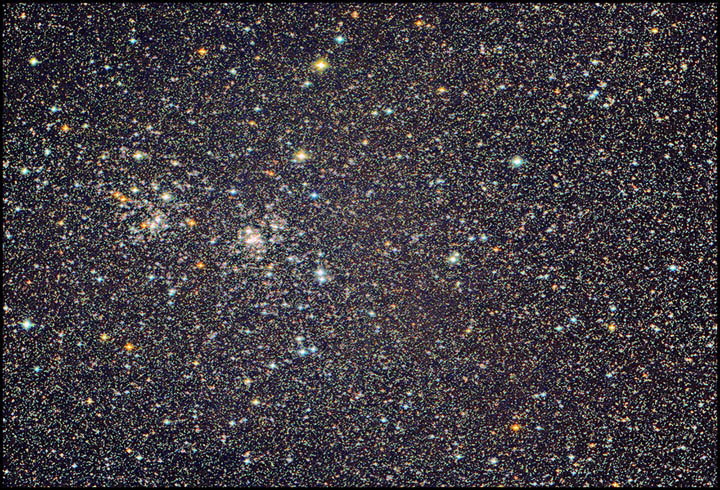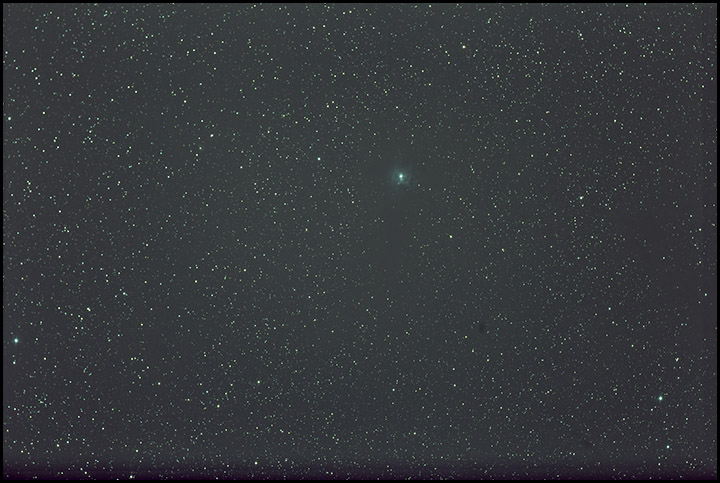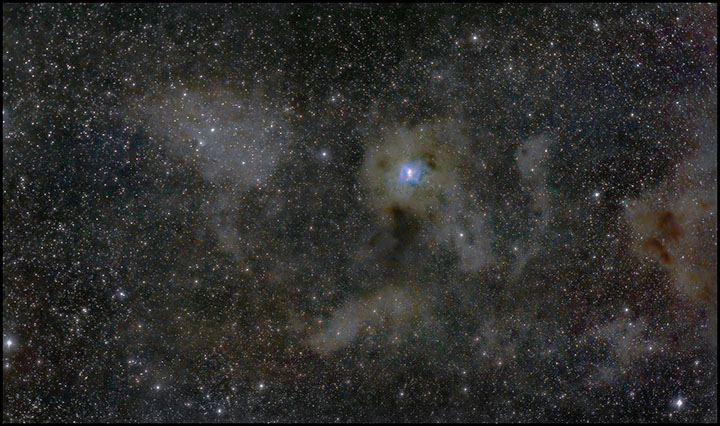Dark Nebulae
9/17/2015. There is indeed a dark nebula west of the Double Cluster, and the dark river that seems to flow between the Cocoon nebula and M39 shows up nicely. Here's a deeper look at the Double Cluster than yesterday night's "glimpse." This is five hours' exposure (wanted a bit more, but the camera battery quit). The splotch is better seen in the large version of the image.

The Double Cluster and an anonymous dark cloud
AT65EDQ, Canon 6D @ ISO 1600 (cropped)
G11, PHD guiding
100 x 180s (5h00m)
(Click the image for a bigger version)
I can't believe I thought that photo was worth showing off. The distorted stars are due to a poor dewshield kludge (see next page). We'll be trying this one again soon, but I'm leaving the mess posted for humility's sake.
Many, many times under dark skies, I've used 20x100 and 14x70 binoculars to try to navigate the dark river that extends from the Cocoon all the way to loose open cluster M39. A widefield photo shows both deep sky objects and the dark lanes between them:

The Cocoon Nebula and M39 with dark river betwixt
52 x 180s (2h36m)
Same hardware as above.
(Click the image to enlarge.)
I thought the Kendrick battery was going to be the limiting factor last night because I had to charge the computer early on, and I'd set up over eight hours of imaging. The Kendrick held up very well. Nevertheless, in the morning, I verified how the quick connector I installed to accept a supplemental battery is wired (it's reversed from the "battery tender" standard but allows mini alligator clamps to be attached to a second battery "correctly"). I'll make 110% certain of that before trying it. The ability to hook up a supplemental battery is crucial way out yonder.
The limit, such as it was, was the Canon 6D internal battery. It ran just over five hours; I'd set up six. Not a big deal here and now, but again, it matters if the camera dies unexpectedly after I've spent hundreds of bucks and many days getting out into the dark. So an Orion 12v adapter for the 6D is on the way.
The timer, the guider, everything else worked great. Tonight, I should get to use two SD cards to keep a much better eye on what's happening under the stars. This evening, I found the M39 field "the old fashioned way" by centering Deneb and using the G11's engraved setting circles to hit the mark. Retro much?
9/18/2015. The second SD card has already paid off. I was trying to compose a shot of the Iris Nebula and the bizarre hoodoos of the Cepheus flare. I wanted to begin on the east side of the mount and simply track all night and into dawn. The camera was upside-down and tucked up under the mount to start. Once again, I tried an offset from Deneb (20 minutes of RA East, 23 degrees north) but this time I ended up a few degrees away from where I meant to be. I shot a few frames and brought them to the main computer where I could take a good look at some 3-minute subs. I recognized the error of my ways and went back up to set it right. I should install some light-weight review software on the guide computer, shouldn't I? Or maybe Backyard EOS for camera management, too, though it may want more oomph than my netbook can provide. Just something to keep from contorting and squinting too much and something to review the take when my office isn't at hand. [No, online commentary holds that BackyardEOS runs OK on a netbook; it even anticipates such use with custom modes for smaller screens. Trial copy installed, running well ... enough.]
Six hours and twenty-seven minutes of exposure time later, what I've got is the Iris Nebula standing in a field of dusty stars. The computer kept the guide star right where I wanted it and shut off when commanded, the timer ran out on the G11 exactly on cue, the (2nd) camera battery lasted just long enough (I put in a fresh one at half past midnight).
This is what each one of the 129 sub-exposures looks like straight out of the camera. I had to crop the finished stack to remove the shadow of the raised mirror from the bottom of the frames and to make use of only image real estate common to all frames from before and after slightly jostling the camera when I changed the battery. No flats, darks, bias frames or any other sissy calibration stuff.

Here's the stack of 129 frames averaged and histogram-stretched with just a rudimentary color-balancing pass. Keep in mind that these JPEG show-and-tell shots have just 8-bits per color channel while the images from the camera have 14-bits per channel. So it's not entirely surprising that some of the stuff I pulled up from "the shadows" is utterly invisible here.

From here on it's just cropping, masking, and stretching. A lot of masking and stretching, sometimes channel by channel. And some noise suppression. And some dynamic range work. And implicit flatfielding. And some more masking and stretching. Did I mention masking and stretching? Practice, Mister! Practice.
The 6D is said to have a quantum efficiency of about 45-48% (for every hundred photons striking its detector, 45-48 are counted) which is comparable to a decent astronomical CCD, but the Canon is not thermoelectrically cooled to help control electronic noise, and cameras made especially for this service describe intensity using 16-bits rather than 14. Still...
There are exquisite shapes in those dust clouds, but you can't really tell it in this photo. Maybe if I quadrupled the exposure. With this camera, these skies, that telescope, and my current processing skills, what I wanted was a little beyond tonight's reach. The 10-inch Newtonian deserves a chance. When the weather wills. In the meantime, I wouldn't be surprised if this image gets reprocessed a few times. Just for the record, we're on about version 8.7 since I first posted this. And now, after spending more time in PixInsight than I spent shooting, I'm getting happier with it. It's not what I had in mind, but it's progressed to something better than awful.

NGC 7023 amid the dark and light dust clouds of Cepheus
129 x 180s (6h27m)
(Click for a better view, but it needs work. It's coming along.)
Except where noted, deep-sky photos are made with an SBIG ST2000XM CCD behind a 10-inch Astro-Tech Ritchey-Chretien carried on an Astro-Physics Mach1GTO. The CCD is equipped with Baader wide- and narrow-band filters. The internal guide chip of the CCD most often keeps the OTA pointed in the right direction (I'll let you know when an OAG or guidescope takes its place). Camera control and guiding are handled by Maxim DL 5.12. The stock focuser on the AT10RC has been augmented with Robofocus 3.0.9 using adapters turned on the lathe downstairs. A Canon 6D and a modded 50D find themselves mounted on an Orion 10" F4 Newtonian or carrying widefield glass on an iOptron Skytracker. Beginning in May 2013, PixInsight has taken over more and more of the heavy lifting -- alignment, stacking, gradient removal, noise-reduction, transfer function modification, color calibration, and deconvolution. Photoshop CS4 et seq and the Focus Magic plugin get their licks in, too.
:: top ::